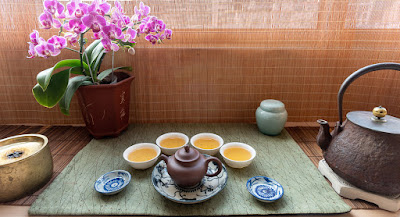This spring, I'm back in San Hsia in the south of New Taipei City. This is one of the few tea regions in Taiwan that specializes in green tea (leaves without any oxidation). This production was originally intended for the Mainland Chinese officials who came with Chiang Kai Shek in 1949. Those who came from Northern regions were used to drinking green tea and habits are difficult to change! And since the state of war between the Communists and the Nationalists prevented any trade, their only solution was to find farmers to help them make green tea in Taiwan.

Since green tea is all about lightness and pure aromas, it's quite important that it should be grown organically. The trick to see spot an organic tea garden is to look at the feet of the tea bushes. Here, we see plenty of weed and a lots of insects! In one part of the garden, nature is actually overtaking the tea trees. Since the farmer is only working with his father, he doesn't have enough time to uproot all the weeds by himself. To compensate for the loss, he is planting new tea trees that will be easier to harvest (his harvesters are 80 years old neighbors!)
However, these new tea trees will only start to produce tea in 3 years...
On the picture below, you can see how the tea garden is slowly being invaded from the right.
I visited the garden on March 22nd, when temperatures reached 30 degrees Celsius at noon! Thanks to abundant rain fall this winter, there's a good growth of new tea.
However, with such heat, the aromas are already loosing some of their spring freshness. In theory, the best grade of green tea is harvested before the QingMin festival on April 5th. But in practice, the earlier the better, because that's when the weather is still cool, but just warm enough to grow some small leaves.
That's why, the batch I have selected was harvested on
March 6!
The farmer used the Qingxin Ganzhong cultivar and turned this tea into a BiLuoChun. It was emperor QianLong (1711-1799) who invented this poetic name for this tea. It means Jade Snail Spring and it replaced a very crude name: tea so fragrant that it scares people to death!!
The next day, I tested this SanHsia BiLuoChun in 2 different bowls. In a dark green glazed porcelain bowl by Michel François with a deep and tall shape:
And I also brewed it in this shallow celadon bowl from the late Qing dynasty. This test showed the impact of the shape of the tea bowl on the taste of the tea. The shallow celadon bowl has lighter aromas, because its large surface in contact with air cools down faster. Its tea is more refined and thirst quenching.
The tall bowl has more power and the brew remains hot longer. And thanks to the very high quality of these leaves, the brew doesn't get bitter easily (provided you use few leaves, fewer than for Oolong).
Since everybody is staying at home right now, some readers have suggested I give tea lessons on my
Facebook page. So, I will try to do so and I want to focus them on the subject of Chaxi. Because if meditation is a way to live in the present, the Chaxi is a way to enjoy life where we make our Chaxi. My goal is to make you feel so comfortable at home brewing tea that you won't want to go out (at least not before the threat is over)! See you soon.











































